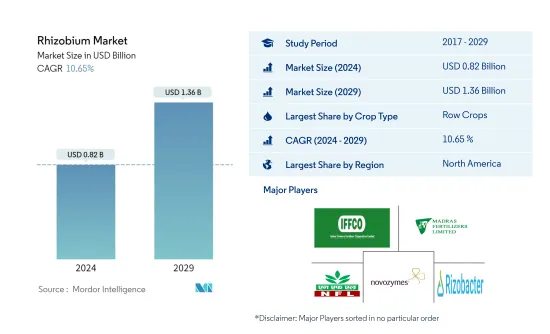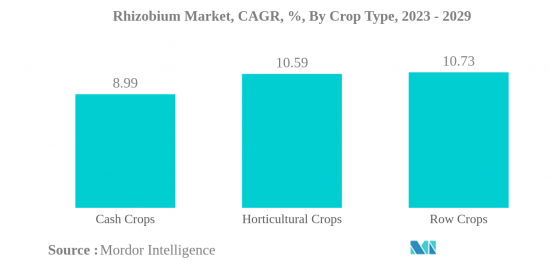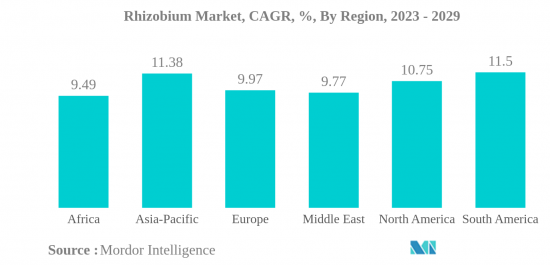 |
市場調査レポート
商品コード
1430570
根粒菌:市場シェア分析、産業動向・統計、成長予測(2024年~2029年)Rhizobium - Market Share Analysis, Industry Trends & Statistics, Growth Forecasts (2024 - 2029) |
||||||
● お客様のご希望に応じて、既存データの加工や未掲載情報(例:国別セグメント)の追加などの対応が可能です。 詳細はお問い合わせください。
| 根粒菌:市場シェア分析、産業動向・統計、成長予測(2024年~2029年) |
|
出版日: 2024年02月15日
発行: Mordor Intelligence
ページ情報: 英文 279 Pages
納期: 2~3営業日
|
- 全表示
- 概要
- 目次
根粒菌市場規模は2024年に8億2,000万米ドルと推定され、2029年には13億6,000万米ドルに達すると予測され、予測期間中(2024-2029年)にCAGR 10.65%で成長する見込みです。

主なハイライト
- 畑作物が最大の作物タイプです。根粒菌とマメ科植物の根との相互作用により、高度に制御されたプロセスが形成され、大気中の窒素が同化可能な植物栄養素に変換されます。
- 連作作物は最も急速に成長している作物です。大麦、トウモロコシ、小麦、菜種、ライ麦、ヒマワリ、大豆、稲が世界的に栽培されています。北米と欧州地域の連作作物の消費が市場を独占しています。
- 北米は最大の地域です。米国とカナダで連作作物の有機栽培が増加した結果、この地域で根粒菌ベースのバイオ肥料の使用が増加しました。
- 米国が最大の国。同国ではトウモロコシ、大豆、コメ、小麦、アルファルファが生産され、畑作物の有機栽培面積が拡大し、2017年から2022年にかけて27.4%増加しました。
根粒菌市場の動向
畑作物が最大の作物タイプ
- 根粒菌とマメ科植物の根との特異的な相互作用により、高度に制御されたモジュレーションと呼ばれるプロセスが形成され、大気中の窒素を同化可能な植物栄養素に変換します。この能力は、畑作物生産における細菌接種剤の使用の基礎となります。2022年の菌根菌市場は、連作作物が市場金額の約69.7%を占め、支配的でした。世界的に最も重要な連作作物は、大麦、トウモロコシ、小麦、菜種、ライ麦、ヒマワリ、大豆、米です。
- 園芸作物における根粒菌ベースのバイオ肥料市場は、2022年に4,900トンが使用され、1億3,720万米ドルになると予想されています。根粒菌株はトマトやピーマンの根に着生し、生産の様々な段階で成長を促し、苗や果実の収量や品質を向上させる。また、トマトやトウガラシなどの温室栽培や、その他の園芸果実栽培にも利用されています。
- コーヒー、紅茶、ココア、綿花、サトウキビ、菜種、ヒマワリ、タバコは、世界的に栽培されている主要な換金作物です。2022年の根粒菌ベースのバイオ肥料の市場価値は、換金作物が6,870万米ドルを占めました。北米が換金作物市場を独占し、2022年には約5,220万米ドルを占めました。
- 根粒菌の接種は、無機窒素肥料の需要を減少させながら、植物に必要な窒素を供給することができます。効果的な根粒菌接種は、収量を高めるために必要な全窒素の最大50~70%を供給することができます。根粒菌はまた、ビタミン、アミノ酸、シデロフォア、オーキシン、窒素固定を生成します。
- 上記の特徴と根粒菌をベースとする肥料の用途の増加により、市場は予測期間中に成長すると予想されます。

北米が最大の地域
- 根粒菌は植物と共生関係にあり、マメ科植物の根粒に生息する最も重要な窒素固定細菌です。根粒菌はバイオ肥料の中で世界で2番目に消費量が多く、2022年には25.4%のシェアを占める。
- 根粒菌の微生物活動により、さまざまなマメ科作物で年間1ヘクタールあたり40~250kgの窒素が固定されると推定されています。欧州連合(EU)は、マメ科作物の栽培面積の拡大を通じて、持続可能な植物性タンパク質生産への移行を計画しています。
- 北米が世界の根粒菌市場を独占し、2022年の市場シェアは52.7%でした。北米の根粒菌バイオ肥料市場は連作作物が支配的で、2022年の市場金額の約62.4%を占めています。連作作物が優勢なのは、根粒菌が連作作物に含まれるマメ科作物と共生しているためです。この地域では連作作物の栽培が盛んであるため、市場価値は増加し、予測期間中にCAGR 13.0%を記録すると予想されます。
- 非レギューム作物では、作物の収量ポテンシャルを高めるために窒素の追加散布の必要性が高いです。生物学的窒素固定細菌の使用は、穀物、果物、野菜のような非反芻作物の生産を増加させることができます。根粒菌バイオ肥料市場は耕作作物が支配的で、畑作物の栽培面積が広いため、2022年の市場金額の約69.8%を占めています。根粒菌バイオ肥料を果物や野菜作物に適用することで、栄養の利用性が高まり、必要な植物ホルモンが生成されることが知られています。

根粒菌産業の概要
根粒菌市場は断片化されており、上位5社で28.14%を占めています。この市場の主要企業は、Indian Farmers Fertiliser Cooperative Limited、Madras Fertilizers Limited、National Fertilizers Limited、Novozymes、Rizobacterになります。(アルファベット順)
その他の特典:
- エクセル形式の市場予測(ME)シート
- 3ヶ月間のアナリスト・サポート
目次
第1章 エグゼクティブサマリーと主な調査結果
第2章 レポートのオファー
第3章 イントロダクション
- 調査の前提条件と市場定義
- 調査範囲
- 調査手法
第4章 主要産業動向
- 有機栽培面積
- 一人当たりのオーガニック製品への支出
- 規制の枠組み
- バリューチェーンと流通チャネル分析
第5章 市場セグメンテーション
- 作物タイプ
- 換金作物
- 園芸作物
- 耕作作物
- 地域
- アフリカ
- 国別
- エジプト
- ナイジェリア
- 南アフリカ
- その他のアフリカ
- アジア太平洋
- 国別
- オーストラリア
- 中国
- インド
- インドネシア
- 日本
- フィリピン
- タイ
- ベトナム
- その他アジア太平洋地域
- 欧州
- 国別
- フランス
- ドイツ
- イタリア
- オランダ
- ロシア
- スペイン
- トルコ
- 英国
- その他欧州
- 中東
- 国別
- イラン
- サウジアラビア
- その他中東
- 北米
- 国別
- カナダ
- メキシコ
- 米国
- その他北米地域
- 南米
- 国別
- アルゼンチン
- ブラジル
- その他南米
- アフリカ
第6章 競合情勢
- 主要な戦略動向
- 市場シェア分析
- 企業情勢
- 企業プロファイル
- Indian Farmers Fertiliser Cooperative Limited
- Indogulf BioAg LLC(Biotech Division of Indogulf Company)
- IPL Biologicals Limited
- Lallemand Inc.
- Madras Fertilizers Limited
- National Fertilizers Limited
- Novozymes
- Rizobacter
- T Stanes and Company Limited
- Vittia Group
第7章 CEOへの主な戦略的質問CEOへの主な戦略的質問
第8章 付録
- 世界概要
- 概要
- ファイブフォース分析フレームワーク
- 世界・バリューチェーン分析
- 市場力学(DROs)
- 情報源と参考文献
- 図表一覧
- 主要洞察
- データパック
- 用語集
The Rhizobium Market size is estimated at USD 0.82 billion in 2024, and is expected to reach USD 1.36 billion by 2029, growing at a CAGR of 10.65% during the forecast period (2024-2029).

Key Highlights
- Row Crops is the Largest Crop Type. The interaction between rhizobia and legume roots results in the formation of a highly regulated process converts atmospheric nitrogen into an assimilable plant nutrient.
- Row Crops is the Fastest-growing Crop Type. Barley, maize, wheat, rapeseed, rye, sunflower, soybean, and rice crops formed globally. North America and Europe regions row crop's consumption dominating the market.
- North America is the Largest Region. The increased organic cultivation of row crops in the United states and Canada resulted in an increase in the use of rhizobia-based biofertilizers in the region.
- United States is the Largest Country. Corn, soybeans, rice, wheat, and alfalfa are produced in the country and the organic area under cultivation of field crops has expanded, increased by 27.4% from 2017 to 2022.
Rhizobium Market Trends
Row Crops is the largest Crop Type
- The specific interaction between rhizobia and legume roots results in the formation of a highly regulated process termed modulation, which converts atmospheric nitrogen into an assimilable plant nutrient. This ability provides the basis for the use of bacterial inoculants in field crop production. Row crops dominated the mycorrhiza market in 2022, accounting for around 69.7% of market value. Globally, the most important row crops are barley, maize, wheat, rapeseed, rye, sunflower, soybean, and rice.
- The market for rhizobium-based biofertilizers in horticultural crops is expected to be worth USD 137.2 million, with 4.9 thousand metric tons used in 2022. Rhizobium strains colonize the roots of tomato and pepper plants to encourage growth at various stages of production, increasing seedling and fruit yield and quality. It is also utilized in greenhouse culture, such as tomato and capsicum farming, as well as other horticultural fruit growing.
- Coffee, tea, cocoa, cotton, sugarcane, rapeseed, sunflower, and tobacco are some of the major cash crops grown globally. Cash crops accounted for USD 68.7 million in the market value of rhizobium-based biofertilizers in 2022. North America dominated the market for cash crops and accounted for about USD 52.2 million in 2022.
- Rhizobium inoculation can provide plant nitrogen requirements while decreasing the demand for inorganic nitrogen fertilizer. Effective rhizobium inoculation can deliver up to 50-70% of the total nitrogen required to boost yields. Rhizobium also generates vitamins, amino acids, siderophores, auxins, and nitrogen fixation.
- Owing to the above-mentioned characteristics and the increase in the application of rhizobium-based fertilizers, the market is anticipated to grow during the forecast period.

North America is the largest Region
- Rhizobium is the most important nitrogen-fixing bacterium that exists in a symbiotic relationship with plants and lives in the root nodules of leguminous plants. Rhizobium is the second most consumed among biofertilizers globally and accounted for a share of 25.4% in the year 2022.
- It has been estimated that 40-250 kg of nitrogen per hectare per year is fixed by different legume crops by the microbial activities of rhizobium. The European Union is planning to make the transition toward sustainable plant protein production through the expansion of the area under leguminous crop cultivation.
- North America dominated the global rhizobium market with a market share of 52.7% in 2022. Row crops dominate the rhizobium biofertilizer market in North America, and they accounted for about 62.4% of the market value in 2022. The dominance of row crops is due to rhizobium's symbiotic association with leguminous crops, which come under row crops. Due to the large cultivation of row crops in the region, their market value is anticipated to increase, registering a CAGR of 13.0% during the forecast period.
- The requirement for additional application of nitrogen in non-leguminous crops is high in order to enhance the yield potential of the crops. The usage of biological nitrogen-fixing bacteria can increase the production of non-leguminous crops like cereals, fruits, and vegetables. Row crops dominate the rhizobium biofertilizer market and accounted for about 69.8% of the market value in 2022, owing to the large area under the cultivation of field crops. The application of rhizobium biofertilizers in fruit and vegetable crops is known to increase nutrient availability and produce required plant hormones.

Rhizobium Industry Overview
The Rhizobium Market is fragmented, with the top five companies occupying 28.14%. The major players in this market are Indian Farmers Fertiliser Cooperative Limited, Madras Fertilizers Limited, National Fertilizers Limited, Novozymes and Rizobacter (sorted alphabetically).
Additional Benefits:
- The market estimate (ME) sheet in Excel format
- 3 months of analyst support
TABLE OF CONTENTS
1 EXECUTIVE SUMMARY & KEY FINDINGS
2 REPORT OFFERS
3 INTRODUCTION
- 3.1 Study Assumptions & Market Definition
- 3.2 Scope of the Study
- 3.3 Research Methodology
4 KEY INDUSTRY TRENDS
- 4.1 Area Under Organic Cultivation
- 4.2 Per Capita Spending On Organic Products
- 4.3 Regulatory Framework
- 4.4 Value Chain & Distribution Channel Analysis
5 MARKET SEGMENTATION
- 5.1 Crop Type
- 5.1.1 Cash Crops
- 5.1.2 Horticultural Crops
- 5.1.3 Row Crops
- 5.2 Region
- 5.2.1 Africa
- 5.2.1.1 By Country
- 5.2.1.1.1 Egypt
- 5.2.1.1.2 Nigeria
- 5.2.1.1.3 South Africa
- 5.2.1.1.4 Rest of Africa
- 5.2.2 Asia-Pacific
- 5.2.2.1 By Country
- 5.2.2.1.1 Australia
- 5.2.2.1.2 China
- 5.2.2.1.3 India
- 5.2.2.1.4 Indonesia
- 5.2.2.1.5 Japan
- 5.2.2.1.6 Philippines
- 5.2.2.1.7 Thailand
- 5.2.2.1.8 Vietnam
- 5.2.2.1.9 Rest of Asia-Pacific
- 5.2.3 Europe
- 5.2.3.1 By Country
- 5.2.3.1.1 France
- 5.2.3.1.2 Germany
- 5.2.3.1.3 Italy
- 5.2.3.1.4 Netherlands
- 5.2.3.1.5 Russia
- 5.2.3.1.6 Spain
- 5.2.3.1.7 Turkey
- 5.2.3.1.8 United Kingdom
- 5.2.3.1.9 Rest of Europe
- 5.2.4 Middle East
- 5.2.4.1 By Country
- 5.2.4.1.1 Iran
- 5.2.4.1.2 Saudi Arabia
- 5.2.4.1.3 Rest of Middle East
- 5.2.5 North America
- 5.2.5.1 By Country
- 5.2.5.1.1 Canada
- 5.2.5.1.2 Mexico
- 5.2.5.1.3 United States
- 5.2.5.1.4 Rest of North America
- 5.2.6 South America
- 5.2.6.1 By Country
- 5.2.6.1.1 Argentina
- 5.2.6.1.2 Brazil
- 5.2.6.1.3 Rest of South America
- 5.2.1 Africa
6 COMPETITIVE LANDSCAPE
- 6.1 Key Strategic Moves
- 6.2 Market Share Analysis
- 6.3 Company Landscape
- 6.4 Company Profiles
- 6.4.1 Indian Farmers Fertiliser Cooperative Limited
- 6.4.2 Indogulf BioAg LLC (Biotech Division of Indogulf Company)
- 6.4.3 IPL Biologicals Limited
- 6.4.4 Lallemand Inc.
- 6.4.5 Madras Fertilizers Limited
- 6.4.6 National Fertilizers Limited
- 6.4.7 Novozymes
- 6.4.8 Rizobacter
- 6.4.9 T Stanes and Company Limited
- 6.4.10 Vittia Group
7 KEY STRATEGIC QUESTIONS FOR AGRICULTURAL BIOLOGICALS CEOS
8 APPENDIX
- 8.1 Global Overview
- 8.1.1 Overview
- 8.1.2 Porter's Five Forces Framework
- 8.1.3 Global Value Chain Analysis
- 8.1.4 Market Dynamics (DROs)
- 8.2 Sources & References
- 8.3 List of Tables & Figures
- 8.4 Primary Insights
- 8.5 Data Pack
- 8.6 Glossary of Terms
